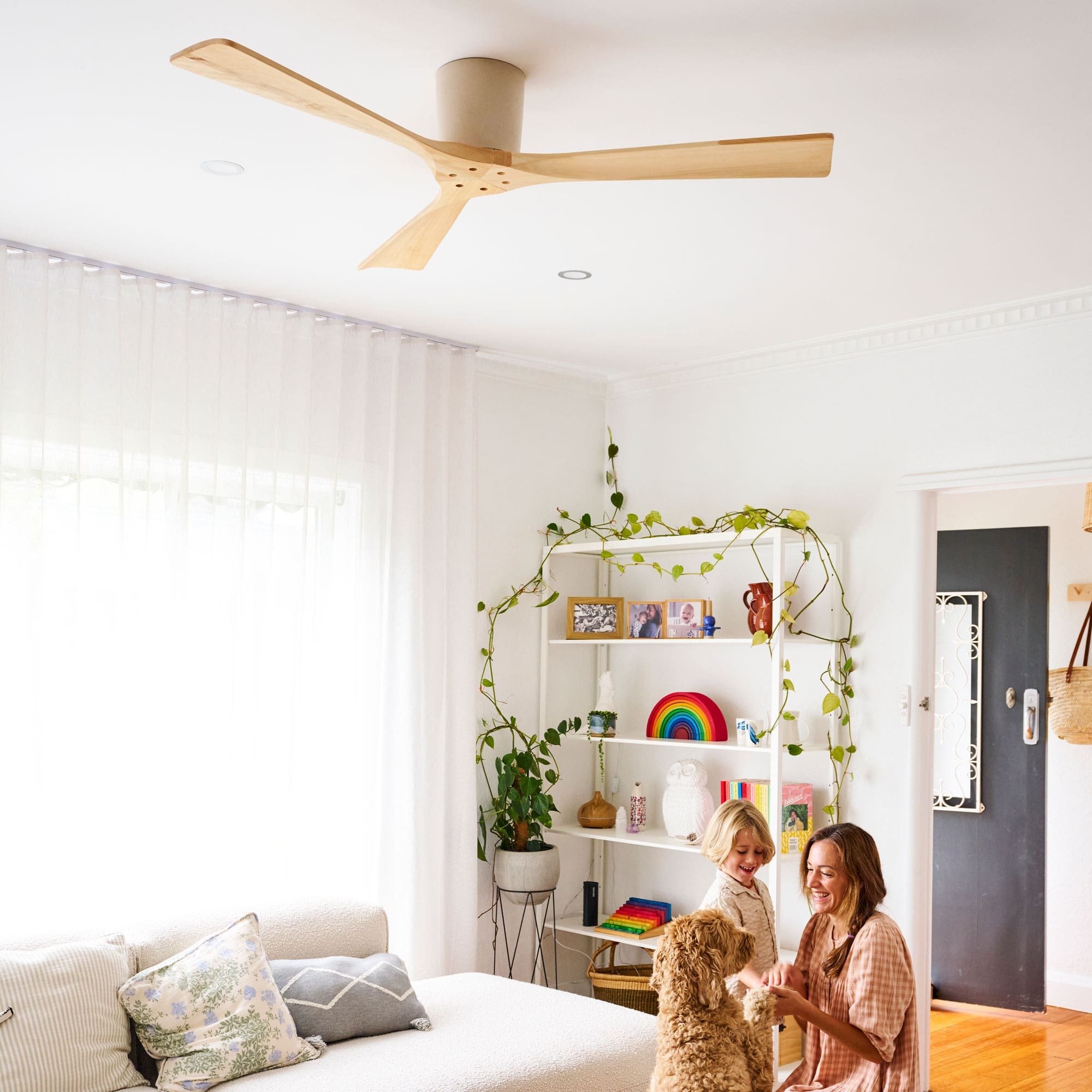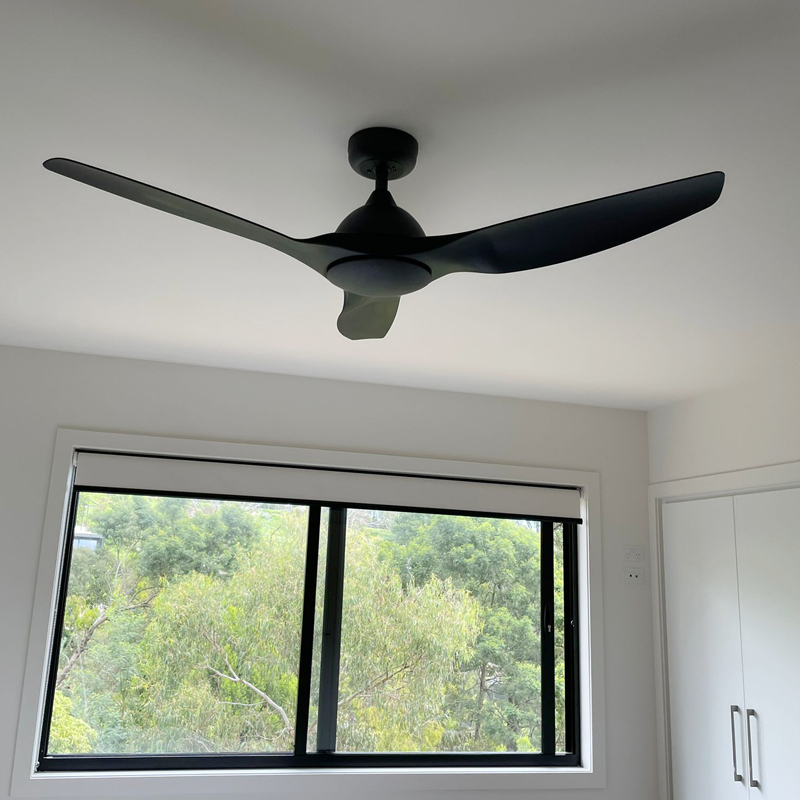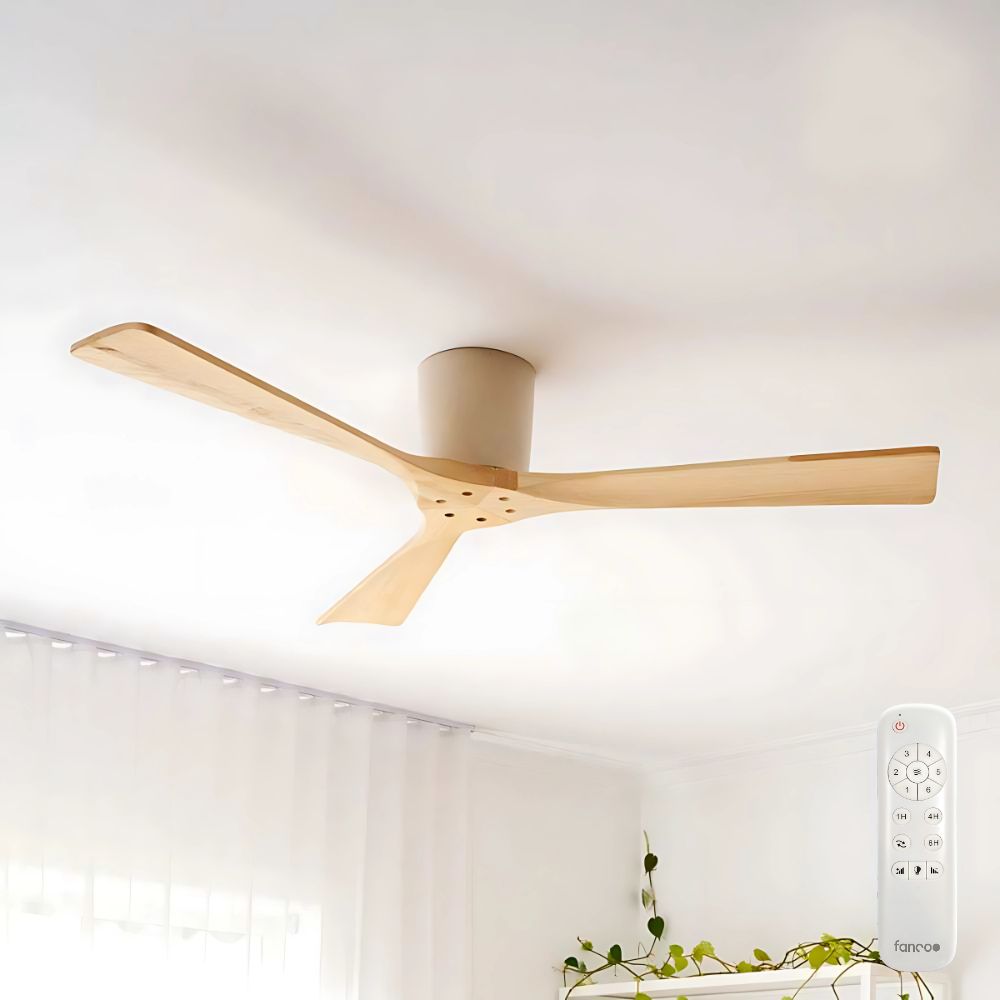How Much Does a Ceiling Fan Cost to Run in Australia?
Page Updated: May 2025
Read Time: 8 Minutes
With energy prices climbing and sustainability becoming an increasingly relevant concern, more Australians are asking: How much does a ceiling fan cost to run? Whether you’re weighing up cooling options or simply want to make the most out of your fan, we’ve broken down everything you need to know.
“[Electric ceiling fans] are a very cheap form of cooling, and cost only a few cents per hour to run.” – Sustainability Victoria
This article will guide you through calculating fan costs and includes real-world examples using average Australian electricity rates and provide helpful insights into making your heating and cooling as cost-effective as possible.

Quick Summary
(Click to scroll to)
Why Ceiling Fans are a Cost-Effective Option:
Cost of living and energy efficiency are now front of mind for many Australians, it’s helpful to know which methods of cooling stand out as being both effective – and cheap to run.
Electric ceiling fans are one of the most energy-efficient ways to stay cool.
“Ceiling, wall-mounted or portable electric fans can be a cheap and effective way to stay comfortable on warm days and, humid summer nights.” – Sustainability Victoria
They don’t lower room temperature like air conditioners do, but they do create a wind-chill effect that helps your body cool itself more efficiently. The result? You can feel cooler without blasting the air con — and at a fraction of the cost.

Thanks to its DC motor, the Choice Rated Fanco Horizon is a High Airflow fan that uses very little energy.
Understanding Fan Motors (It really matters!):
The Heart of the Fan, AC vs DC motors.
Ceiling Fans are powered by one of two types of motors, AC or DC.
By their nature fans have an inherently low energy usage, especially DC fans. However each motor type has advantages that make them both equally viable for very cost effective cooling.
Without getting into the specific engineering nitty-gritty of this, we have prepared a very simplified set of examples to showcase the difference between the two.
If you would like to get a more in depth understanding of this you can read more here.
Benefits of AC (Alternating Current) Motors:
- Generally cheaper with many quality options under the $200 mark
- Typically uses more reliable and simple hard-wired wall controls
- More straightforward designs with less chance of components aging
The Fanco Breeze AC is a popular 3-blade AC fan with a modern design and approachable price point.
Benefits of DC (Direct Current) Motors:
- More Modern Technology – uses 70% less energy than AC fans
- Faster to respond to controls and has more speed options, usually double the options an AC fan has.
- More compact and lighter motor, allowing for sleeker fan designs
Ultra modern, completely silent, and one of the most energy efficient fans available, the Aeratron AE3+ features a DC motor.
Fansonline Top Tip!
Factors That Influence Ceiling Fan Costs:
1. Motor Type:
DC motors are far more efficient than AC motors. They’re quieter, smoother, and consume significantly less electricity.
2. Fan Size:
Larger fans use more energy, but they also move more air — meaning they can often be run at lower speeds for the same cooling effect.
3. Fan Speed:
Lower speeds dramatically reduce energy use. Running a fan on low for 8 hours a day might cost under $1 per summer.
Comparing AC & DC Motor Running Costs
To put these differences into a more approachable context, have prepared these tables comparing two very popular AC and DC fans from the same product family – The Claro Whisper. Both these fans share the specs of a typical 48-52” fan – the same type of fan commonly used for bedrooms – and paint a very clear picture of the differences between AC and DC fans.
Prices are based off the average energy prices from finder.com – that being 32c per kWh.
AC Fans:
Claro’s Whisper AC (left) ceiling fan offers a sleek modern design at an affordable price point, making it a Great value bedroom fan.
| Fan Speed | Power | Monthly Running cost | Cost to run over summer |
| Low | 18W | $1.43 | $4.17 |
| Medium | 34W | $2.72 | $7.92 |
| High | 55W | $4.38 | $12.74 |
Prices based off combined Australian average 32c per kWh – Source: finder.com.
Prices based on running fan for 8 hours a day & summer cost based on fan used for 90 days.

DC Fans:
The Claro Whisper DC (left) has the same sleek design language as its little-AC-sister, but thanks to its DC motor is significantly more cost efficient.
| Fan Speed | Power | Monthly Running cost | Cost to run over summer |
| Low | 1.7W | $0.13 | $0.39 |
| Medium | 6W | $0.47 | $1.39 |
| High | 26.7W | $2.13 | $6.20 |
Prices based off combined Australian average 32c per kWh – Source: finder.com.
Prices based on running fan for 8 hours a day & summer cost based on fan used for 90 days.

Ceiling Fan Cost to Run Calculator (Formula + Example):
So how did we calculate these examples, and how can you do the same?
Simply follow these steps: (click to expand)
To keep things simple, Wattage is essentially how much electricity your fan will be using.
With this information can do some basic maths to figure out what the fans CPH (Cost Per Hour) will be – Don’t worry, we will walk you through the process step by step with an example.
For our example we are using the Claro Whisper DC again, the same fan we used in our DC table above. For our calculations we are going to use its medium “3” speed, which uses only 6 Watts of electricity.
Fan’s Watts (W) ÷ 1000 = kWh
Using our Example:
6 ÷ 1000 = 0.006
kWH × Energy Tariff (cost per kWh) = cost (in cents) per hour (CPHc)
We are again using the average energy price from finder.com in our Example:
0.006 × 32c = 0.192c per hour
CPHc ÷ 100 = cost (in dollars) per hour (CPHd)
Using our example:
0.192c per hour ÷ 100 = $0.0019
Fansonline Top Tip!
We list Wattage* in the Airflow Tab of the Fan’s Listing:

*Wattage listed when provided by manufacturer
Congratulations, you now know how much a fan will cost to run!
You can take this further by multiplying the amount per hour to find out how much your fan will cost if you leave it on for days, weeks, or even all of summer. The price will change depending on what you pay for energy, and which fan model you choose, as well as if your fan has a light that is switched on.
Regardless; and as you can plainly see, we are dealing with costs under a cent per hour.
It’s very clear that Ceiling Fans use very little energy on their own even on high speeds, and this gives makes them an invaluable cost saving measure for cooling your home.
Our Recommendations for the Best Energy Efficient Ceiling for Australia:
Energy Efficient DC Fans
Energy Efficient AC Fans
Other Ways to Reduce Cooling Costs
Combine Ceiling Fans + Air conditioning Together:
Pairing ceiling fans with your air conditioning or ducted system is one of the smartest ways to reduce energy costs without compromising comfort. Fans help circulate the cooled air far evenly throughout your home, meaning your air conditioning doesn’t have to work as hard or run as long.
“Ceiling fans can be used in conjunction with an air conditioner to make your home more comfortable by creating a cooling breeze and enabling you to feel comfortable at a higher thermostat setting – this reduces the energy consumption of the air conditioner.” – Sustainability Victoria
The US department of Energy has calculated that with a fan running, you can raise your thermostat by up to 4°C and still feel equally as cool, compared to just running the Air Conditioning as per normal — And every degree higher can translate into real savings on your energy bill. The combination of Ceiling Fan and Air Con is a simple, effective way to stay comfortable and cut cooling costs during the peaks of the Australian Summer.
Fansonline Top Tip!
Positioning Matters!
Ensure the area you spend most of your time is getting the most airflow – and you are getting the most out of your fan.
Position your fan where you spend most time in the room, Example:
Over your seating, bed or work area.
Using fans in Winter with ‘Winter’ (or ‘Reverse’) mode:
Ceiling fans aren’t just for summer; they can also help in winter. By switching the direction the fan blades spin (often called reverse mode or winter mode), the way the fan circulates air changes and the warm air that naturally rises to the ceiling is now pushed back down into the habitable areas. This efficiently redistributes heat and can make rooms feel warmer for longer – allowing you to lower your heating settings and save on energy costs.
“In winter, this can be used to push hot air up towards the ceiling and back down around the edges of the room to mix with cooler lower-level air, breaking up the layer of hot air at ceiling level and making it warmer where you need it to be.”- Sustainability Victoria

When in reverse mode, the Fanco Infinity-iD uses its DC motor to keep circulating raised hot air back down to the surface, helping reduce heating costs.
Conclusion: Cheap, Effective, Everyday Cooling
Ceiling fans are a simple, energy-smart way to enhance your home’s comfort—year-round. When used thoughtfully, they can significantly reduce reliance on more expensive heating and cooling systems, leading to meaningful long-term savings. Whether you’re pairing a fan with your air conditioner in summer, using reverse mode in winter to circulate warm air, or just running the fans on their own the benefits go far beyond comfort.
Ready to make a smarter choice for your home?
Explore our range of ceiling fans designed with efficiency in mind, and feel free to contact our team today—we’re here to help you find the perfect solution for your space.
Ceiling Fan Energy Efficiency FAQ:
As little as 0.1 cent per hour on low speed.
Anywhere from under 1 cent to 15 cents per 8-hour day, depending on speed and fan type.
Assuming you run a fan for around 8 hours a day, 7 days of usage will usually be between under $1 to under $2, depending on usage and type of motor.
From under $0.20 up to under $5, depending on usage and type of motor.
Ceiling fans cost a fraction of the price. They’re a great first step before turning on the Air Con, or a tool that can boost the effectiveness of your air-conditioning allowing you to run your aircon on lower settings, with the same or even greater cooling effects.
Yes they do! When fans are swapped to ‘Winter Mode’ (sometimes called ‘Reverse Mode’) the motor swaps direction and the blades spin the opposite direction. Now, instead of blowing cold air straight down, the fans now circulate hot air that may be pooling in the ceiling area back into reach. You can Learn more about ‘Winter Mode’ here.
Use our simple formula:
(Watts ÷ 1000) x (your electricity rate).
See more about your electricity rate here.
Get Expert Advice from Fansonline
Contact us today to learn more and take the first step towards a more energy-efficient home.
Choosing the right ceiling fan can significantly impact your comfort and energy bills. At Fansonline, our experts are ready to assist you in selecting the ideal fan for your needs.















